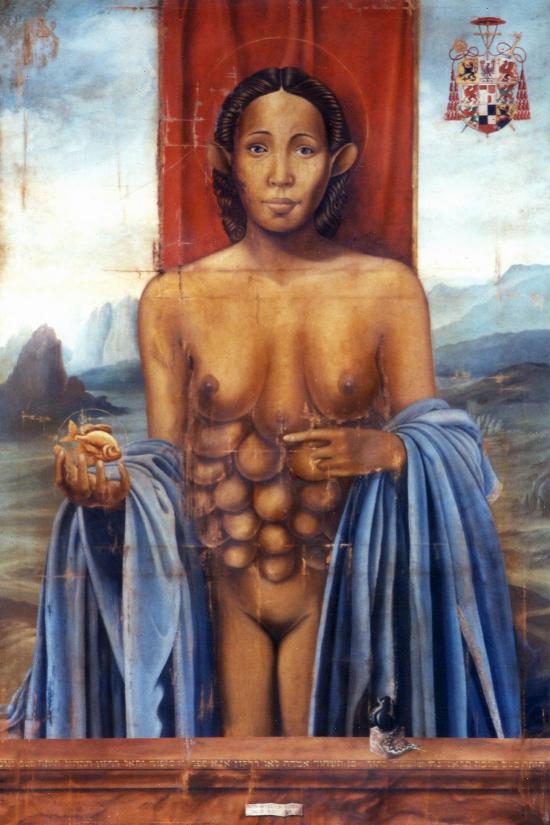|
"Our Lady" |
|
Madre di tutti, Immanuel Novazio nicknamed "el Pota", 1544 oil on canvas, cm 180 x 110 |
|
|
|
Magnify the painting at the most (Not included in the tour, 212 KB)
|
|
It's impossible to denie that Mother of All Men is an original painting. A black and nude Madonna, with many breasts, animal ears, three vertical marks on each cheek and two crosses cut into the forehead, holds, suspended on a hand, a fish of gold, towards that the forefinger of the other hand invites us to look at. The lowered shoulder emphasizes both corporeal and Passion's weight, being the fish and the gold two symbols of Christianity. On the drapery left side behind the Virgin's head, we can see indistinctly a face in profile in the background's clouds. A noble and cardinal blazon, abounding in details, is evident on the right side. On one side of the borders of the blue mantel coming down from the forearms is gold embroidered a short-cut Latin motto, on the other a procession of ants. A viper bringing in its mouth the letter Aleph runs away rolling down from the black egg and the marmoreal cube that stay, one upon the other, upon the sill in the painting's down side. A Hebraic inscription runs along the full length of the sill border. On its front there is a cartouche containing the date 1544 and the painter's signature, while in an angle it appears the name Georg, with the "o" replaced by the symbol of the sun, surmounted by that of the infinite and spangled with little golden spots. So Mother of All Men mixes in itself some elements of catholic traditional iconography, like the blue mantle, the red drapery and the areolas of the Virgin and the fish, with some specific traits of pagan deities, like nudity, breasts in many lines and animal ears. Of all alterations made to the typical figure of Madonna with Baby, in the painter's letter are quoted only the nudity (with appearance of nude African woman), the breasts (with so many breasts) and the fish of gold (in stead of the Divine Infant). Novazio was inspired by Leonardo for the background, by Crivelli or Bellini for the drapery and the sill, and by Mantegna for the hidden profile. Even if the blazon and the profile permits to locate the German cardinal Albert of Brandenburg (1490-1545) as the certain consignee of the painting, we have no proof that it was also him the customer; first because the letter is written in Italian (but it could be a draft for the translator), and second it addresses an unspecified Most illustrious and Most excellent my Lord, epistolary heading of deference not rare in the sixteenth-century, but not sufficiently obsequious for a big shot as the cardinal Albert. On the back there are no traces of sealing-wax, therefore it's a copy or the never sent original letter. Since the cardinal's court (see biographic note) had no lack of able and reputed artists, the most reliable hypothesis is that the customer was a noble Lombard connected with the cardinal Albert by friendship or business, who wanted to give him the painting as a present, perhaps without he was informed about. Till proof to the contrary, Mother of All Men is the only painting of Immanuel Novazio arrived to us. We know nothing about the pala in Sancta Maria and the portraits of Brembati couple, quoted in the letter as works already realized by the painter. Since Novazio worked in the atelier of a certain maestro Giovanni, the afore-said paintings maybe are known under other titles and bring other signatures. It has not been possible to trace back neither the knight Nappo, man of the customer's trust , nor the faithful servant Amel acting as model, nor brother Paul who charges her with sorcery. At the moment, the reasons inspiring this painting remain unknown. However it strikes us as to be in front of a determined will to fuse the old with the new, with the intention to get the classicism spiritual values back, and to use them as a support for the modernity, in the abjuration's atmosphere of Mary's sanctity generated by Lutheran Reformation. |

